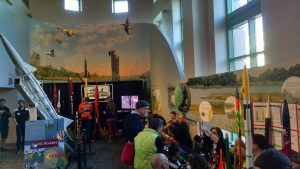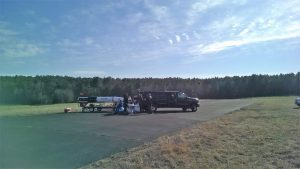Every year we have an exhibit at Astronomy Days in late January to introduce people to the hobby of model rocketry. We get a lot of people asking about launches local to the Triangle.
We have scheduled launches in Butner, but only in the summer. To get people who are interested out to a launch as soon as possible, we have held a launch in Butner the week after Astronomy Days for the last few years.
Sometimes we get a nice warm weekend in February, but not so this year. Highs were in the low 40s. At least the winds were very light. We were set up and ready to fly at 10AM, but most people did not show up until noon or so.
We had a total of 30 flights, ranging from B to G motors. No high power H flights this time.
| Motor Size | Flights |
| B | 1 |
| C | 10 |
| D | 2 |
| E | 1 |
| F | 9 |
| G | 7 |
| Total | 30 |
Chef Paul Schaefer brought his rocket grill and tried to keep us all warm with burgers and other food. He is still raising money for the launch of his half scale Nike Ajax (seen in the picture above).
Dan Fritz and Mike Nay kept people entertained with many G powered flights. A loud G75 Metalstorm in Mike’s G-force really woke up the crowd.
Dan and Mike had many flights using a Jolly Logic Chute Release to delay opening the main parachute until a low altitude. Normally these have been working fine, but I witnessed some failures to open the chutes at this launch. Hopefully they have figured out what the problem(s) were. If you are using a Chute Release you may want to consult them, as they seem to have the most experience with the device.
The two Jordan High School TARC teams were at the launch testing out their egg carrying rockets and a new 12 foot 1010 rail. Hopefully the longer rail will result in straighter flights and less variation from flight to flight. The TARC objective this year is to fly to exactly 775 feet and stay in the air for 41-43 seconds. Repeat performance is a key.?They has a total of 6 F39-7 powered flights.
Mike Nay tried a two stage Estes Ascender using two F15 motors. As expected, the low thrust F15 did not have enough power to get the rocket moving fast enough off the rod. It had a nice arcing ballistic flight and was recovered at the edge of the field?in good shape. Switching to a 1010 rail would be a good idea for the heavier Estes Pro Series rockets using the low thrust E and F motors.
Aaron and Paul Schaefer, as well as Aaron’s friend Travis, flew most of the C flights in a variety of small rockets.
Jackson Fuller, 5 years old, was a new flyer at our launches, I believe. He flew an Estes Flash on a C6-5. Young Mansour Mohamed was back for a single flight of a red/silver Estes rocket on a C6-5.
Jimmy Blackley entertained us with a had a single flight with a Big Daddy and an F26 black smoke motor.
We had a few cars of new spectators who saw us at Astronomy Days. Hopefully we will see them again with rockets in the summer.
For the summer Butner launches, we now have two 1010 rail launches, one with a 12 foot rail, and one with the standard 8 foot rail. We should be able to avoid launch rail congestion this year. We also have up to seven low power launch pads with 1/8″, 3/16″ and 1/4″ rods. We also have?a 6?foot 80/20 20mm mini rail. It?is a?good replacement for the low power rods, and I encourage people to use it.
I hope to see you all in Butner during the warm summer months.
Dave Morey



